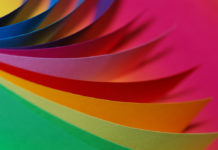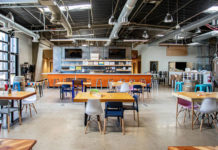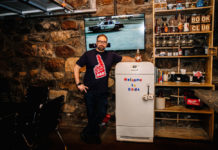When building a new bar from scratch, the lighting design is one of the single most important aspects to consider, and can be one of the most costly as well. But if your current space could use a makeover, and the current economy doesn’t exactly warrant faith in outlandish expenditures, you do have options.
Low-cost lighting renovations can be had through the art of deception, and when done right, the results can be impressive. “Someone coming into the same space for four years, seeing the same bar, the same approach, etc., is the patron that needs a new experience,” says Vincent Conigliaro, owner and president of lighting and sound specialist company Salvin Design (www.salvin.biz), in Kingston, New York. “And those are where the changes need to be made. Make that person turn left where he used to turn right.”
Conigliaro has seen a recent upswing in bar owners contracting Salvin to work with their venues’ existing structures, fixtures, and even lighting hardware, and yet still deliver a new customer environment.
“The facelift,” as Conigliaro calls it, “is based on what an owner wants to do versus how much they can spend. With lighting, this can be done by re-arranging what you already have. Move something on the truss. Put a mirror here, remove one from there.
“It’s really the most easily changeable thing in a club, because lights now have the ability to change position, color, and shape. Those are easy things to alter these days with the swipe of a mouse. The hard thing to change is a customer’s perspective on where he is. But that can be done with color or positioning; re-direct the clientele.”
George Saviolidis, president of GS FiberLite, Inc., of Lake Worth, Florida, recently saw his company contracted by Nexxus Lighting (www.nexxuslighting.com) of Charlotte, North Carolina, to install the lighting at the Bleau Bar inside the Fontainebleau hotel in Miami Beach, Florida, part of a $1 billion renovation. The owners desired a certain ambience that only a well-designed lighting concept could deliver. Nexxus Lighting chose its LED light fixtures to put the “blue” in the signature Bleau Bar by installing fixtures in the translucent floor. Additionally, Nexxus Lighting’s Fiber Optic solutions were used to create a back-lit effect on the glass panels throughout the resort’s lobby and entrance.

“They wanted the floor to change colors for different themes and different events, and essentially they wanted to make it look like you’re walking on water,” says Saviolidis. “You need to take into consideration that it’s a glass floor at a bar area, so they’ll be cleaning it with mops and people will be spilling drinks. They asked my opinion on what we should use for an environment like this, and I decided they should use waterproof LED lighting, that way there would be no problems down the road.”
There is a reliance upon lighting to create environments and, sometimes, illusions, that makes these installations challenging, while rewarding and unique. On the Bleau Bar job, cost became a factor. “LEDs are the best option out there, especially compared to conventional lighting,” says Saviolidis. “But for specialty projects, like the fiber optics we put around the frames of some 200 glass panels, you need to take into account maintenance and longevity. Some of these systems cost more than Ferraris.”
Another project, handled by Nexxus Lighting subsidiary Advanced Lighting Systems (www.advancedlighting.com) of Sauk Centre, Minnesota, involved the installation of architectural lighting at the Tulalip Resort Casino Lounge in Tulalip, Washington. Color-changing LED lighting systems were installed throughout the luxury hotel, which use the LiveLED series of fixtures and the Sunlite DMX controller by Nicolaudie (www.nicolaudie.com) to create color changing effects that enhance the overall guest experience.
“The lighting for a venue like the Tulalip Lounge needed to be dynamic, not static,” says Paul Benton, western regional manager at Advanced Lighting. “This project showcased the capabilities of our color changing LiveLED system and enhances the overall experience for the hotel guests. In this industry, this type of architectural lighting for entertainment venues—bars, clubs, lounges, ultra-lounges—is referred to as ‘architainment.’”
According to Benton, 10% of a club owner’s budget should be earmarked for lighting. And whatever that number amounts to, the folks at Salvin are confident they can make a difference.
“Whatever the owner has to spend, that’s what we can get the job done with,” says Conigliaro. “It can be done.”
Conigliaro adds that second-hand equipment should always be considered an option for effective lighting facelifts at low cost. “Owners shouldn’t be afraid of buying a used piece of equipment if it’s from a reputable company, because they can get very good deals,” he says. “I’m not talking about buying out of the back of somebody’s truck. Go to Guitar Center, or Salvin. If a seller backs it up with a good warranty, it’s a good way to go. One man’s junk is another man’s treasure.”
If used equipment gives you pause, the investment in LED lighting, though sometimes significant up front, will pay off in the long run.

“Let’s say an average lighting project is $50,000, but an owner wants something that is maintenance-free and looks good,” asks Saviolidis. “Conventional lighting will be half the cost, but with LEDs and fiber optics, they’ll save 60-80% on electrical consumption. Your maintenance costs go down, since you don’t need to change fixtures a couple of times a year. You’ll maybe need to change the fixture five to ten years down the road.”
Salvin’s consulting and design work has shown its ability to take something steeped in one style or shade, and make drastic changes through seemingly simple solutions. “Color has always been a psychological thing in clubs—from saloons back in the days of Buffalo Bill, which were always red and many still are today,” says Conigliaro. “Those tones—600 nanometers to 550 nanometers in the lightwave spectrum—create a warmness, and people look good in those shades.
“Something simple like changing out hanging light fixtures over the bar and softening them up can make a big difference. We put lampshades over the globes in one venue, and it gave an entirely new look to the bar. And that was very inexpensive; I think the shades were four dollars at Wal-Mart.”
Both Conigliaro and Saviolidis emphasize the role that a club owner has to play in deciding which road to take in the lighting game, and the steps involved in making such choices.
“A lot of club owners don’t realize it’s time for change because they don’t step outside of themselves. Step back and re-evaluate the look of the club with nobody in it. They need to put themselves in the line outside their door and stand there and say, ‘What am I doing here? What am I looking at?’ It’s the simple things that distract people from thinking about where they are now, where they were last night—they’re just in the moment in your club.”








